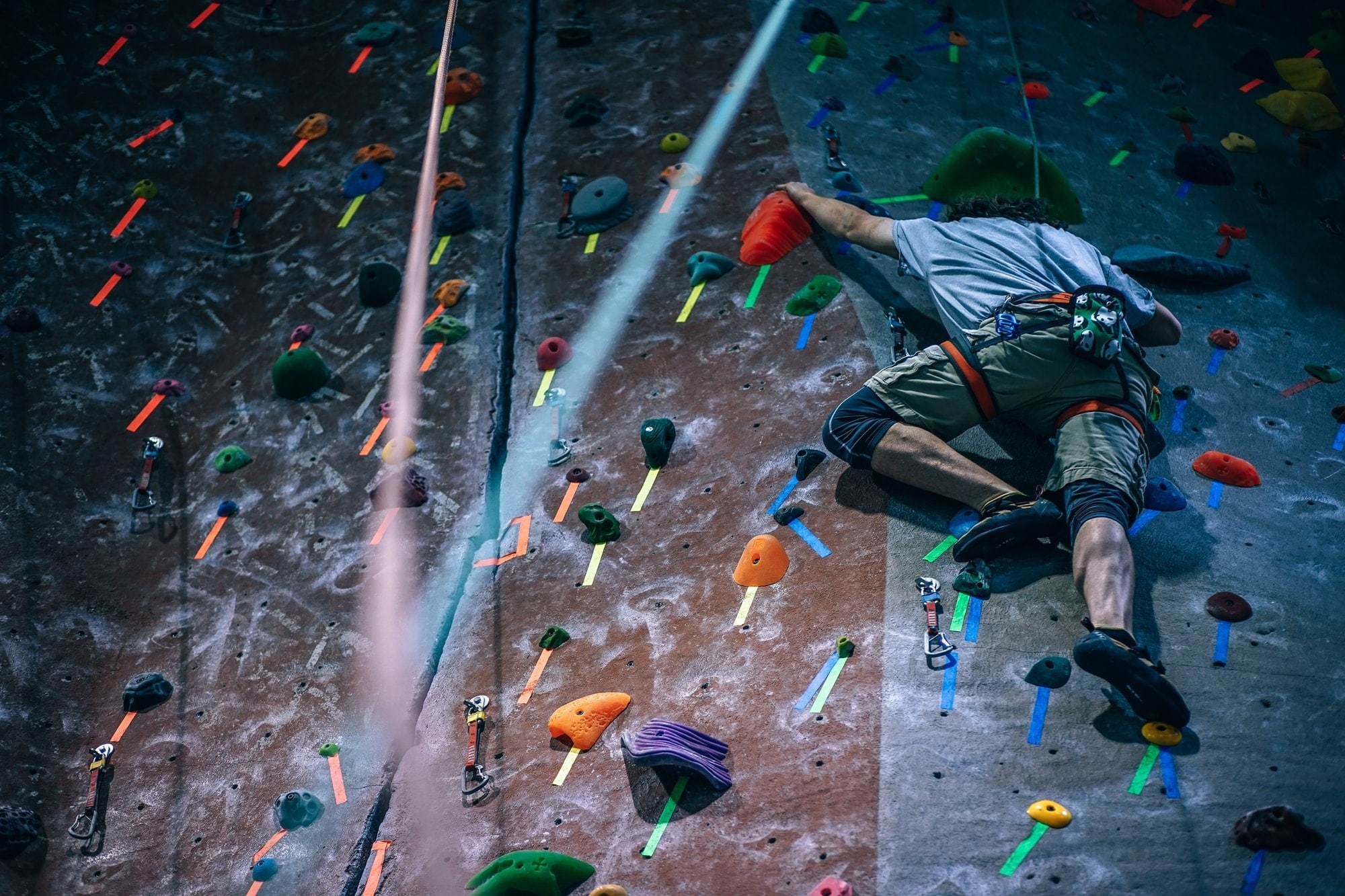While you’re getting started, there’s one key trick to progress:
CLIMB … a lot!
Some new climbers find themselves able to climb nearly daily, whereas other new climbers opt for 2-3 days per week. Less than two days per week at the gym or crag and progress will be a slower journey. As follows are tips to get the most out of your first six months.
Avoid injury
As many experienced climbers can attest, injury is one of the primary restrictors from progress.
It’s important to listen to your body; take sufficient rest as your muscles seek recovery. Here are a few tips for staying injury-free:
- Stay away from tendon-intensive holds and training exercises in your first six months. Tendons take longer to gain strength than your muscles, so many newer climbers that progress to thin, powerful crimps too fast will find themselves with injury.
- Use recovery tools to relax your muscles and stimulate healing.
- Train antagonist muscle groups. Rock climbing is composed of mostly pulling motions, which put great strain on your back muscles and biceps. Your fingers, too, are always pulling into the same clenched position. Developing balance with your antagonist muscles is important to avoid injury and climb longer into the future. Try finishing your climbing sessions with a few pushing exercises, such as push-ups, and by working your fingers in their opposite direction (two ways to do this: 1) put a few pounds of rice in a bucket, make a fist that you dunk into the bucket, and open up your hand so that your fingers are opening against the pressure of the rice; and 2) use a special finger training device such as the TheraBand Hand Xtrainer
).
Get better, not stronger
According to Rock and Ice, “Dani Andrada, a Spanish crusher and one of the best climbers in the world, was rumored to have redpointed 50 5.13b’s before he even considered getting on a 5.13c.”
While the grades 5.13b and 5.13c may not be on your current horizon, the message is simple:
Focus on getting better, not stronger.
Practice proper etiquette
Climbers tend to be easy-going. However, there’s definitely a code of conduct that’s easily overlooked.
If you’d like to fit in and not push any wrong buttons, it’s important to understand proper etiquette. Here are a few tips:
- Keep the beta to yourself! You shouldn’t provide unsolicited tips on how to do the moves of a climb. Many climbers approach their climbs as puzzles, wanting to figure out the moves for themselves. Unless requested, keep the beta to yourself or politely ask the climber: “Would you like some beta?” before speaking.
- Stay aware of whose turn it is to climb. If someone is chalking up near the base of a climb, don’t beat the individual to the wall or hop on an adjacent route that would interfere. Likewise, if someone is brushing the holds of a climb, provide the courtesy of allowing him or her to go next.
- Always climb with your shoes on! This is primarily for gyms, where climbing barefoot is nasty.
- When on ropes, be efficient and allow others to get on the climb. This is particularly true if setting up top ropes: don’t set up the rope and hog the route for hours—give others a turn!
- When outdoors, it’s not advised to top rope off the rappel rings at the top of a climb. Instead, use your own quickdraws/carabiners attached to the anchor so that excessive wear isn’t placed on the permanent gear.
- Don’t climb unsafe—you’re smarter than this and your parents wouldn’t be happy. It also makes for an uncomfortable situation for everyone else at the crag. Be aware that in many areas, permission to rock climb is on shaky grounds and one bad incident may ruin climbing access for everyone. Be safe out there!
Mix up your climbing sessions
As a new climber, it’s important to get exposed to a lot of different movements and styles of climbing.
If you perform best on powerful climbs, consider spending extra time on delicate, technical ones while you develop your climbing skill base.
It’s also useful to mix up the structure of your climbing sessions: climbing hard and pushing your limits some days, while climbing easy and going for mileage on others. Other ways to mix up your climbing are by getting experience on both ropes and bouldering, or by incorporating various climbing games that keep climbing sessions fun and communal.
Which brings us to the most important recommendation …
Have a blast
If you’re not having fun and contributing to a positive environment, it may be wise to take a few days, a couple weeks, or even more time off while you regain your psych.
Many climbers (professionals included) experience climbing in cycles of ups and downs, ensuring to take time off and try something else when motivation plateaus. If climbing isn’t feeling right, try getting on a bike, running, practicing yoga, or pursuing another activity. Your body and mind may need a healthy break from climbing … and that’s okay!
Put simply, follow your intuition and have fun out there.
Interested in more content crafted for beginners? Download our free, 80+ page eBook, Rock Climbing Fundamentals: Essential Terms, Techniques, and Tips for the New Climber.
If you liked this article, we think you’ll also enjoy:
- Gear Guide: Best Equipment for Beginner Climbers
- Essay: What’s in a Grade? — How to Approach Climbing Difficulty
- Pull-Up Progression for Climbers
- 25 Best Books for Climbers
- Looking Back After One Year of Climbing — 10 Lessons Learned
Lastly, don’t forget to check out our most popular articles ever published, free rock climbing eBooks, and the internet’s best climbing gear sales.








